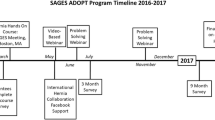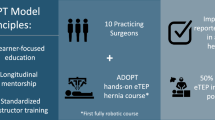Abstract
Background
Practicing surgeons commonly learn new procedures and techniques by attending a “hands-on” course, though trainings are often ineffective at promoting subsequent procedure adoption in practice. We describe implementation of a new program with the SAGES All Things Hernia Hands-On Course, Acquisition of Data for Outcomes and Procedure Transfer (ADOPT), which employs standardized, proven teaching techniques, and 1-year mentorship. Attendee confidence and procedure adoption are compared between standard and ADOPT programs.
Methods
For the pilot ADOPT course implementation, a hands-on course focusing on abdominal wall hernia repair was chosen. ADOPT participants were recruited among enrollees for the standard Hands-On Hernia Course. Enrollment in ADOPT was capped at 10 participants and limited to a 2:1 student-to-faculty ratio, compared to the standard course 22 participants with a 4:1 student-to-faculty ratio. ADOPT mentors interacted with participants through webinars, phone conferences, and continuous email availability throughout the year. All participants were asked to provide pre- and post-course surveys inquiring about the number of targeted hernia procedures performed and related confidence level.
Results
Four of 10 ADOPT participants (40%) and six of 22 standard training participants (27%) returned questionnaires. Over the 3 months following the course, ADOPT participants performed more ventral hernia mesh insertion procedures than standard training participants (median 13 vs. 0.5, p = 0.010) and considerably more total combined procedures (median 26 vs. 7, p = 0.054). Compared to standard training, learners who participated in ADOPT reported greater confidence improvements in employing a components separation via an open approach (p = 0.051), and performing an open transversus abdominis release, though the difference did not achieve statistical significance (p = 0.14).
Discussion
These results suggest that the ADOPT program, with standardized and structured teaching, telementoring, and a longitudinal educational approach, is effective and leads to better transfer of learned skills and procedures to clinical practice.



Similar content being viewed by others
References
Robinson DH, Toledo AH (2012) Historical development of modern anesthesia. J Invest Surg 25:141–149
Gariepy TP (1994) The introduction and acceptance of Listerian antisepsis in the United States. J Hist Med Allied Sci 49:167–206
Semm K (1988) Pelviscopic appendectomy (German). Dtsch Med Wochenschr 113:3–5
Bhattacharya K (2007) Kurt Semm: a laparoscopic crusader. J Minim Access Surg 3(1):35–36
Kelley WE (2008) The evolution of laparoscopy and the revolution in surgery in the decade of the 1990s. JSLS 12:351–357
Tsui C, Klein R, Garabrant M (2013) Minimally invasive surgery: national trends in adoption and future directions for hospital strategy. Surg Endosc 27(7):2253–2257
Paige JT, Farrell TM, Bergman S, Selim N, Harzman AE, Schwarz E, Hori Y, Levine J, Scott DJ (2013) Evolution of practice gaps in gastrointestinal and endoscopic surgery: 2012 report from the Society of American Gastrointestinal and Endoscopic Surgeons (SAGES) Continuing Education Committee. Surg Endosc 27(12):4429–4438
Farrell TM, Bergman S, Selim N, Paige JT, Harzman AE, Schwarz E, Hori Y, Levine J, Scott DJ (2012) Practice gaps in gastrointestinal and endoscopic surgery (2011): a report from the Society of Gastrointestinal and Endoscopic Surgeons (SAGES) Continuing Education Committee. Surg Endosc 26(12):3367–3381
Aggarwal R, Moorthy K, Darzi A (2004) Laparoscopic skills training and assessment. Br J Surg 91(12):1549–1558
Mackenzie H, Cuming T, Miskovic D, Wyles SM, Langsford L, Anderson J, Thomas-Gibson S, Valori R, Hanna GB, Coleman MG, Francis N (2015) Design, delivery, and validation of a trainer curriculum for the national laparoscopic colorectal training program in England. Ann Surg 261(1):149–156
Payne SC, Huffman AH (2005) A longitudinal examination of the influence of mentoring on organizational commitment and turnover. Acad Manag J 48(1):158–168
Sinclair P, Fitzgerald JE, Hornby ST, Shalhoub J (2015) Mentorship in surgical training: current status and a needs assessment for future mentoring programs in surgery. World J Surg 39(2):303–313
Entezami P, Franzblau LE, Chung KC (2012) Mentorship in surgical training: a systematic review. Hand 7(1):30–36
Schlachta CM, Kent SA, Lefebvre KL, McCune ML, Jayaraman S (2009) A model for longitudinal mentoring and telementoring of laparoscopic colon surgery. Surg Endosc 23(7):1634–1638
Schlachta CM, Lefebvre KL, Sorsdahl AK, Jayaraman S (2010) Mentoring and telementoring leads to effective incorporation of laparoscopic colon surgery. Surg Endosc 24(4):841–844
Sebajang H, Trudeau P, Dougall A, Hegge S, McKinley C, Anvari M (2006) The role of telementoring and telerobotic assistance in the provision of laparoscopic colorectal surgery in rural areas. Surg Endosc Other Interv Tech 20(9):1389–1393
Acknowledgements
The authors would like to acknowledge the leaders of the Lapco TT program, colorectal surgical consultants Mark Coleman and Tom Cecil, and research fellow Susannah Wyles, for bringing this revolutionary mentor training program to the USA, training the authors as instructors (JD, JP, BD), and their time, energy, support, and expertise in participating in the training of the course mentors. The authors also wish to thank our world-class surgeon mentors for their enthusiasm, expertise, and time commitment: Drs. William Cobb, William Hope, Mike Liang, Archana Ramaswamy, Shawn Tsuda, and Khashayar Vaziri.
Author information
Authors and Affiliations
Corresponding author
Ethics declarations
Disclosures
Dr. Dort is the Co-Chairman of the Quality, Outcomes, and Safety Committee of SAGES. Dr. Paige receives grant support from HRSA, LSU Board of Regents, Acell, Inc., and Intuitive, Inc., and receives royalties from Oxford University Press. He is also the Chairman of the Continuing Medical Education Committee of SAGES. Ms. Schwarz provides consulting services on behalf of the association management firm, BSC Management, for SAGES. Dr. Dunkin is the Past President of SAGES. Jonathan Dort, Amber Trickey, John Paige, Erin Schwarz and Brian Dunkin have no conflicts of interest or financial ties relevant to the study.
Rights and permissions
About this article
Cite this article
Dort, J., Trickey, A., Paige, J. et al. Hands-on 2.0: improving transfer of training via the Society of American Gastrointestinal and Endoscopic Surgeons (SAGES) Acquisition of Data for Outcomes and Procedure Transfer (ADOPT) program. Surg Endosc 31, 3326–3332 (2017). https://doi.org/10.1007/s00464-016-5366-z
Received:
Accepted:
Published:
Issue Date:
DOI: https://doi.org/10.1007/s00464-016-5366-z




